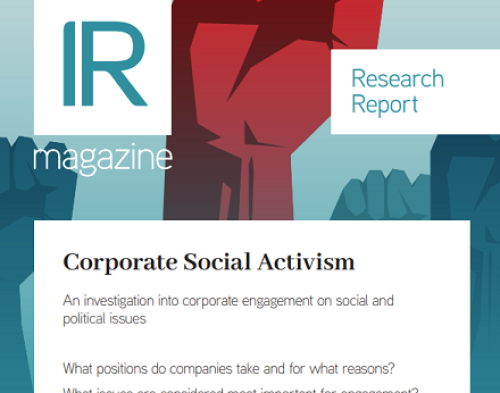‘One could argue that shareholder proposals came into prominence because of social concerns,’ Kellie Huennekens, associate director at EY's Center for Board Matters and an expert of ESG, tells IR Magazine. ‘Stories about the origins of corporate governance include stories about organizations filing shareholder proposals at companies doing business in South Africa during the apartheid regime.’
While the social element of ESG has largely taken a back seat to the more easily quantifiable environmental and governance factors – or been folded into environmental issues – investors are now starting to take a deeper look at that S. But it’s not always so simple.
Around the same time that shareholder concerns around social issues began emerging, Huennekens says environmental issues also made it onto the investor radar. ‘And as you know, some of that overlaps,’ she says. ‘When you’re talking about the impact of a company on a community in which it’s located, not just in which it serves, it’s not just the impact on air, water and soil you need to consider, but also on people.’
Traditionally, these concerns have been voiced through shareholder proposals but Huennekens notes that, more recently, institutions have been publishing stewardship reports highlighting engagement and scorecards and so forth.
Social mores
So what trends is EY picking up on across ESG reporting? ‘We are seeing investors communicate more in terms of what they're looking for companies to disclose,’ she says. ‘They’re asking how corporate practices and policies align with what are considered to be best-in-class practices that are shared by, for example, the Taskforce on Climate-related Financial Disclosures, the Sustainability Accounting Standards Board, the UN-PRI, the Global Reporting Initiative, or the CDP (formerly the Carbon Disclosure Project) – different non-governmental organizations.
‘One of the things that’s really interesting is that you’re also seeing institutional investors get together on different issues and entering into conversations about what they want to see and hear from boards. And you’re seeing them put together guidelines and statements and thought pieces on what they're generally looking for.’
There’s also an increased focus on data around topics such as gender, race and ethnicity-related pay, continues Huennekens, as well as in certain, specific areas of social and environmental issues, although demand for information on these more-specific areas tends to evolve from year to year. The human right to clean water is one current example, she notes. ‘You’re [also] seeing investors asking companies about supply chain related disclosures and everything from animal welfare, to the use of antibiotics in food.’
And this increased focus on the social – and also the environmental – impact of companies is also making it into the boardroom. EY’s 2018 proxy season prereview shows that of the top five areas investors would like companies to prioritize, three have a social or environmental focus, including diversity, climate risk and human capital, while a fourth focuses on compensation and so the last element of ESG – governance. Only one of the top five board priorities highlighted in the research fails to come under the umbrella: in second place EY says investors want companies to prioritize ‘board level expertise that is more aligned with business goals’.
What’s your purpose?
Another element within the social side of ESG – and one that is garnering more attention with today’s tech giants and the growing gig economy, not to mention the more environmentally and socially-focused priorities of millennials – is company purpose.
‘One of the things we’re seeing within the CEO community and also to some extent in the investor community is broader discussion of purpose,’ explains Huennekens. ‘It’s not just What does the corporation do but What does it mean – for its people and for society.
‘And that goes back to how our conversation started: how does the company connect to the broader community in which it lives and serves? How do employees connect and what is the company’s broader purpose?’
As a result, EY is now seeing a more ‘multi-stakeholder’ view towards governance, she notes.
Unfortunately, because of a number of overlaps – on everything from sustainability reporting to lobbying practices – when it comes to environmental and social issues, EY combines data on shareholder proposals for these areas into one number. But you can still see a year-on-year increase. In 2017, E and S accounted for almost half (49 percent) of shareholder proposals submitted in the US, explains Huennekens. That compares with 41 percent in 2016 and 37 percent in 2013.
At the same time, average shareholder support on E and S topics has gradually gone up from below 10 percent in the early 2000s to ‘generally around 22 percent’.
‘That might not sound very high,’ says Huennekens, ‘but if you think of it in terms of average voting support for certain types of proposals – say, sustainability reporting – that consistently now hits around the 30 percent or 40 percent level, that’s a big deal because at 50 percent of votes cast, when a company is considered to have taken insufficient action to carry out the proposal, a number of institutional investors will vote against the re-election of incumbent board members the following year based on their proxy voting policies.’
If you’ve got it, flaunt it
As investors have increasingly asked for information across ESG issues, companies – largely led by larger firms – have begun opening up more on these topics. Now, Huennekens says that ‘over 80 percent of S&P 500 companies provide sustainability-related reporting’ – a broad category that includes a number of social elements.
But the crucial question is: Are companies offering investors what they want when it comes to ESG disclosures? ‘The answer is yes and no,’ says Huennekens. ‘It’s a very complex question and the answers are also complex.’ But one of the problems is that although companies gather a lot of information on the impact of their practices, much of that information is not geared towards external distribution. So companies, listen up: if you have the data, it’s time to share it with your investors.










